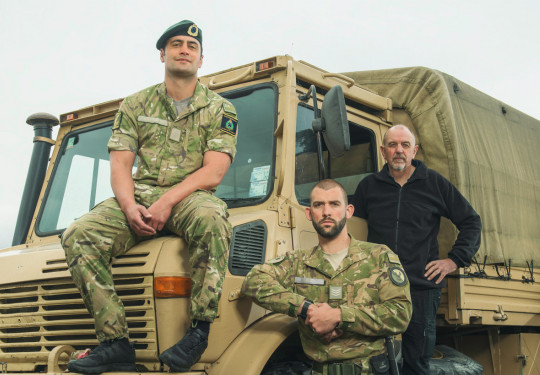Awards for flood rescues
29 September, 2021
Experienced Unimog drivers Mike Chambers, Sergeant (SGT) Callum Hill and Private (PTE) David Arahanga were called to help during the worst flooding ever recorded in the region.
The Wairau River had swollen to the bottom of Opawa Bridge, connecting Blenheim and Picton.
Large tracks of State Highway One were submerged under a metre and a half of flood water, which reached over the Unimogs’ lights, leaving the drivers to steer by torchlight.
Mr Chambers left Blenheim in the evening with Emergency Operations Centre staff and equipment for a medical evacuation mission from Picton’s medical facility. One was a pregnant woman suffering complications and the other was a man who had a broken femur.
“When we got to the bridge, the river was running at over six million litres per second. I’m driving a seven-tonne truck over it very carefully and could see the water splash over the top,” he said.
“We were driving along State Highway One and the water was getting deeper and deeper and deeper. Then the lights started to flicker, which I thought was unusual, but then I realised that the water was so deep, it had come over the headlights. A split second later, we lost all our lights.”
It was raining, pitch black and with no lights Mr Chambers’ passenger had to shine a torch to see the roadside markers.
“We couldn’t stop because if we did, the truck would drown. I knew to keep the revs up over 2500 in a low gear and keep the bow waves ahead of us. To make the situation worse, we were finding floating logs – so as we were going along I was trying to hit the logs with the front of the bumper, so they wouldn’t get caught under the vehicle.”
Further along the highway, Mr Chambers spotted two people stranded in their vehicle, and was able to offer them a lift to Picton.
After arriving at Picton’s medical centre, the patients were secured on stretchers in the back of the vehicle and wrapped up to keep warm and dry from water that was coming into the back of the cab.
“Once they were all loaded on, with the medical equipment, it was about 10pm and we started the slow trip back.”
On the return journey, the water levels had dropped slightly, but floating logs were still a danger, Mr Chambers said.
“We still drove back by torchlight, but at least this time we knew what we were getting into and we were able to predict the road a bit better and keep an eye out for markers and trees and once we reached Tuamarina, about 10km north of Blenheim, there was no more flooding, so it was just a slow, steady trip to Wairoa Hospital.”
Earlier in the day, PTE Arahanga and SGT Hill were deployed to rescue about 30 stranded drivers from the Para Wetlands, north of Blenheim.
“There were quite a few places along the State Highway between Blenheim and Picton where the water was about 1.5m high. We couldn’t see the headlights and so we also had to travel by torchlight,” PTE Arahanga said.
“Once we picked up the people we convoyed back to a supermarket at Spring Creek, about 10 minutes north of Blenheim. The second trip we drove further along the road we bumped into a farmer who had been able to evacuate a number of people from the area and took them to Picton. So our second trip we only needed to pick up four people and brought them back to Blenheim.
“Getting through the water was okay, because I had plenty of training at Waiouru. But it was the first time driving in flooded conditions in a real emergency.”
SGT Hill carried about 17 people who were stranded in their vehicles. It was the first time he had driven in such deep water, but he was able to gauge the depth by keeping an eye on roadside markers, he said.
“It was a little bit nerve wracking to start with, but once I was able to work out the depth from the markers it was okay – it was just a matter of trying to keep to the shallowest parts.
“I’ve never seen flooding like it.”
